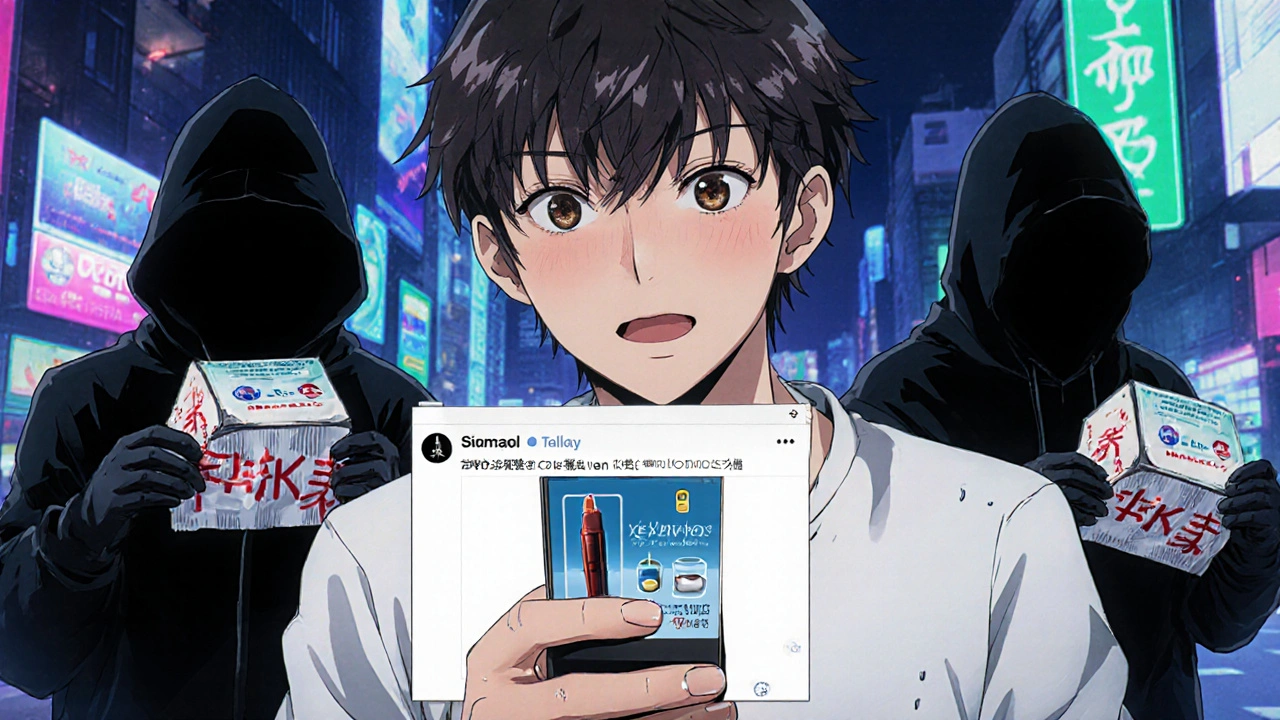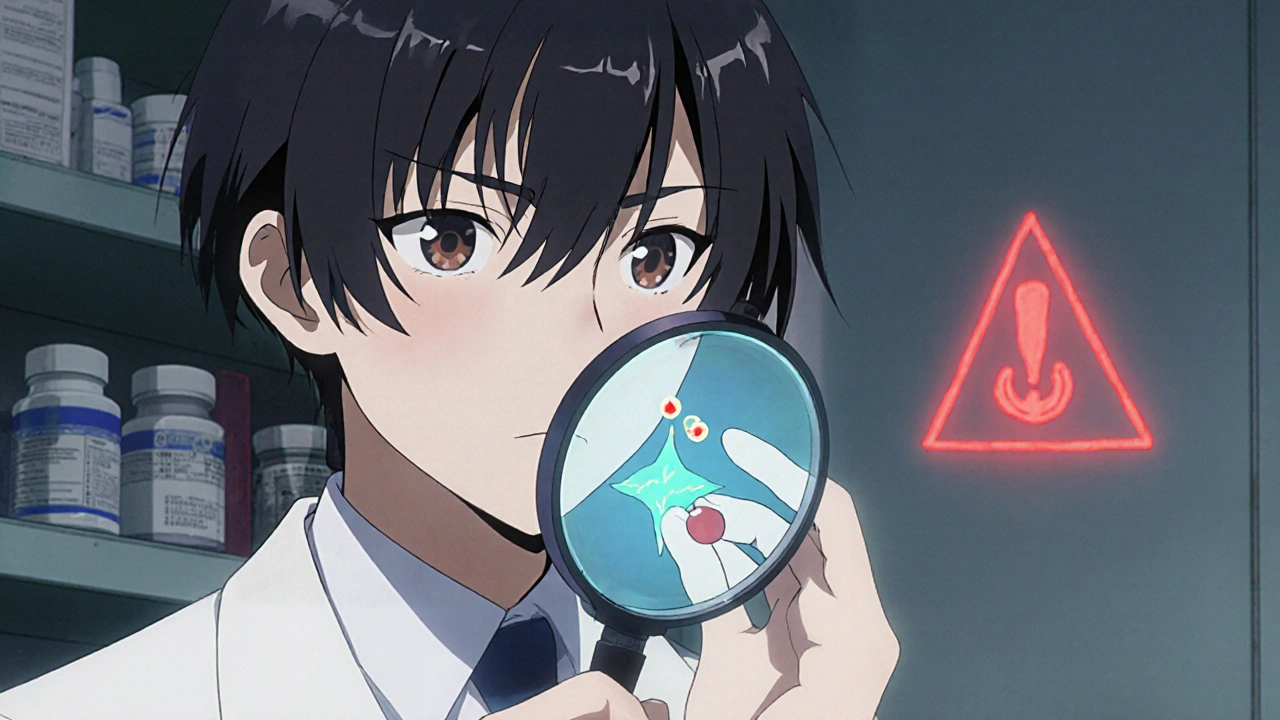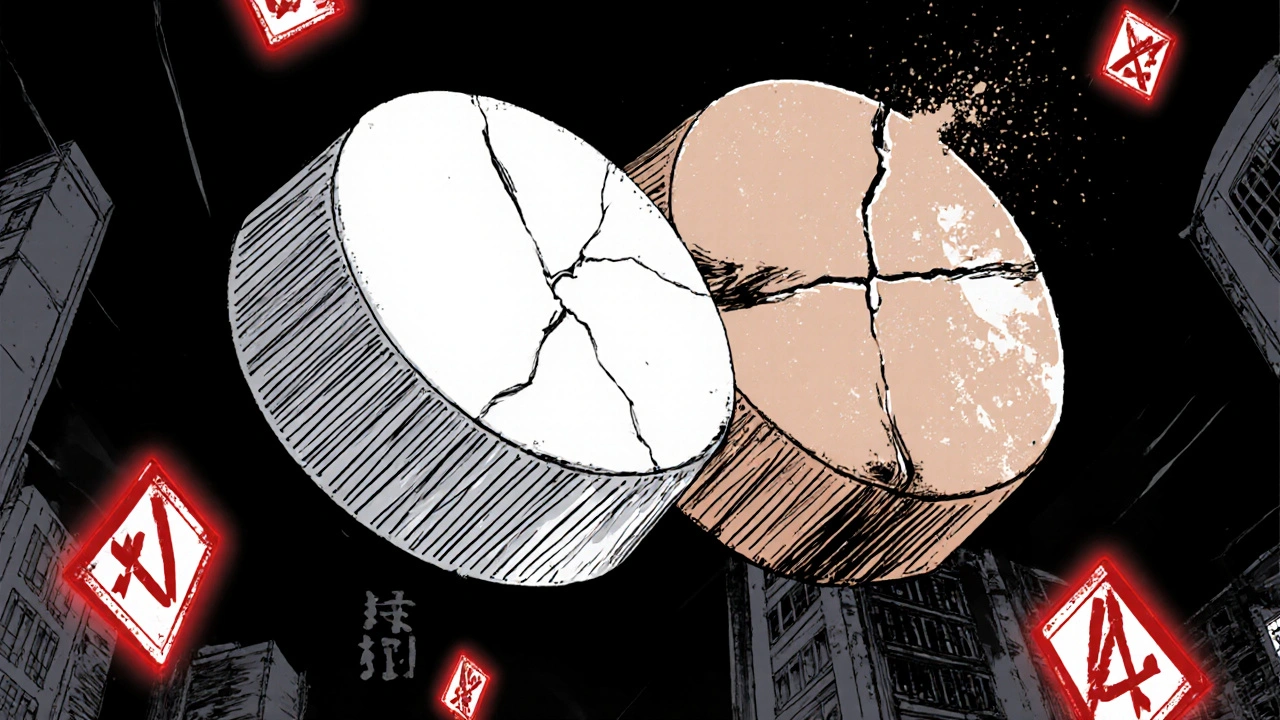Every year, more than a million people die from counterfeit medications. These aren’t just weak or ineffective drugs-they’re dangerous. Some contain rat poison. Others have no active ingredient at all. Some even have too much of a drug, like fentanyl, packed into a pill that looks exactly like your regular Xanax or OxyContin. And they’re easier to find than you think.
What Exactly Is a Counterfeit Medication?
A counterfeit medication is any drug that’s been deliberately and fraudulently mislabeled. It might say it’s Ozempic®, Mounjaro®, or Adderall-but it’s not. It could be made in a hidden lab in China, India, or even a garage in the U.S. There’s no safety check. No quality control. No oversight. These pills are often designed to look identical to the real thing, down to the color, shape, and logo. That’s the trick. They don’t look fake. That’s why they’re so deadly.The World Health Organization distinguishes between two types: substandard drugs (which are real but poorly made or stored) and falsified drugs (which are fake from the start). Most of the dangerous cases fall into the falsified category. The FDA says these products are often sold online, through social media, or by unlicensed street vendors. And they’re growing faster than ever.
How to Spot a Counterfeit Pill or Medicine
You can’t always tell by looking-but there are clear red flags. Here’s what to watch for:- Changes in appearance: If your pills suddenly look different-smaller, bigger, a different color, or with a new marking-it’s not normal. Even a slight shift in shape or texture should raise alarm.
- Unusual taste or smell: If your medication tastes bitter, metallic, or smells odd compared to what you’re used to, stop taking it. Real pills have a consistent, predictable taste. Fake ones often don’t.
- Poor packaging: Check the box or bottle. Spelling errors, mismatched fonts, blurry printing, or faded colors are major signs. Legitimate companies don’t make these mistakes.
- Missing information: No lot number? No expiration date? No pharmacy name or address on the label? That’s not how real medicine is packaged.
- Cracked, crumbly, or bubbled pills: If the coating looks melted, the pill breaks apart easily, or there’s powder or crystals in the bottle, it’s not safe. Pfizer’s experts say real pills are factory-made with precision-no crumbling, no mold.
- Unusually low prices: If you’re buying Ozempic® for $20 a pen when it normally costs over $1,000, you’re being scammed. Counterfeiters lure people in with huge discounts, especially on social media.
- Unlicensed sellers: If you bought it from a website that doesn’t ask for a prescription, or from someone you met on Instagram or Telegram, it’s almost certainly fake.
The FDA warns: if you’ve had a new or unexpected side effect after taking a medication you’ve used before, that’s a warning sign. It could mean the drug you’re taking isn’t what it claims to be.

Where Are Counterfeit Drugs Coming From?
Most fake medications start in unregulated labs overseas. But they’re being shipped directly to consumers through the internet. Criminal networks now use encrypted apps like Telegram and WhatsApp to sell fake pills. They post images that look exactly like real prescriptions, often with fake pharmacy logos and medical credentials.In 2024, the WHO issued a global alert about falsified injectable versions of Mounjaro® and Zepbound®-weight-loss drugs that are in high demand. These weren’t just poorly made. They contained the wrong active ingredients or incorrect concentrations. People using them risked severe side effects, including pancreatitis, kidney failure, or even death.
The DEA says fake pills laced with fentanyl are now the #1 cause of overdose deaths among young adults. These pills look like Adderall, Xanax, or Percocet-but they’re deadly. One pill can kill. And they’re sold as “party pills” or “study aids” to unsuspecting users.
How to Buy Medicine Safely
The only way to be sure you’re getting real medication is to control where you get it.- Only use licensed pharmacies: In the U.S., that means pharmacies licensed by your state board of pharmacy. Avoid any online pharmacy that doesn’t require a prescription.
- Use VIPPS-certified sites: The National Association of Boards of Pharmacy (NABP) runs a program called VIPPS (Verified Internet Pharmacy Practice Sites). Look for their seal on the website. If you don’t see it, walk away.
- Don’t buy from friends or strangers: Never take medication from someone who isn’t a licensed pharmacist. Even if they say it’s “leftover” or “extra,” it could be fake.
- Check your pharmacy: If your local pharmacy starts giving you pills that look different, ask them. Pharmacists are trained to spot counterfeits. They can compare it to previous batches or contact the manufacturer.
- Call your doctor: If you’re unsure about a medication, call your doctor or pharmacist. Don’t guess. They can verify the lot number, check for recalls, or confirm if a change was intentional.
Pharmaceutical companies like Pfizer and Eli Lilly track counterfeit reports. If you have a suspicious pill, call the company’s patient safety line. They can check the lot number and tell you if it’s real. Many have dedicated hotlines just for this.

What to Do If You Find a Counterfeit Drug
If you suspect you’ve been given a fake medication:- Stop taking it immediately. Don’t wait for symptoms.
- Save the packaging and pills. Don’t throw them away. You’ll need them to report it.
- Call your pharmacist. They can help you report it to the FDA or your state board.
- Report it to the FDA: Use their MedWatch program. You can file a report online or by phone. Include the drug name, lot number, where you bought it, and photos of the packaging.
- Call the manufacturer. Eli Lilly, Pfizer, and other companies have dedicated teams to investigate counterfeit reports. Your report could help stop a dangerous batch from reaching others.
Healthcare providers are also encouraged to document suspicious cases-recording patient details, product name, batch number, and why they suspected it was fake. This data helps regulators track patterns and shut down operations faster.
The Bottom Line: Don’t Take Risks
There’s no foolproof way to spot a counterfeit drug without lab testing. Even experts admit that. But you don’t need to be an expert to stay safe. You just need to be careful.Don’t buy medicine from websites that don’t ask for a prescription. Don’t trust social media ads for weight-loss drugs or painkillers. Don’t take pills from someone who says, “I’ve got extra.” And if something looks, tastes, or feels off-stop. Ask. Report.
Counterfeit drugs are a global problem. But your choices matter. By only using licensed pharmacies, asking questions, and reporting suspicious products, you’re not just protecting yourself-you’re helping stop a deadly industry.
Can I tell if a pill is fake just by looking at it?
Sometimes, but not always. Counterfeiters are getting better at copying real pills-down to the color, shape, and imprint. Signs like spelling errors, wrong packaging, or pills that crumble can help, but the only way to be 100% sure is lab testing. If you notice any change in how your medication looks or feels, contact your pharmacist or doctor right away.
Are online pharmacies ever safe?
Only if they’re VIPPS-certified by the National Association of Boards of Pharmacy. These pharmacies are licensed, require valid prescriptions, and follow U.S. safety standards. If a website sells prescription drugs without a prescription, or doesn’t list a physical address or phone number, it’s illegal and dangerous. Avoid them.
What should I do if I bought fake medication online?
Stop using it immediately. Save the packaging and pills. Report it to the FDA through their MedWatch program and contact the manufacturer’s patient safety line. Also, tell your pharmacist and doctor. Reporting helps authorities track and shut down illegal operations.
Why are fake pills so common now?
High demand for popular drugs like Ozempic®, Xanax, and Adderall has created a black market. Criminals exploit this by making cheap, dangerous fakes and selling them through social media and encrypted apps. The rise of e-commerce and global shipping makes it easier to distribute them without detection.
Can counterfeit drugs be harmless?
No. Even if a fake pill doesn’t contain poison, it likely doesn’t have the right active ingredient or dose. That means your condition won’t be treated-leading to worsening illness, complications, or even death. Some fake drugs contain toxic substances like fentanyl, lead, or rat poison. There’s no safe counterfeit.


Darragh McNulty
November 21, 2025 AT 02:58Bro, I just saw a guy on Instagram selling 'Adderall' for $15 a pill. 😳 I almost bought it until I read this. Holy crap. Save your money and your life. 🚫💊
Willie Doherty
November 22, 2025 AT 17:29The systemic failure here is not merely logistical but epistemological. The public’s reliance on visual heuristics for pharmaceutical authenticity reflects a profound epistemic vulnerability in post-industrial healthcare ecosystems. The absence of regulatory oversight in digital marketplaces has created a vacuum wherein ontological certainty regarding pharmacological identity has been rendered obsolete. One must now treat every unverified pharmaceutical agent as a potential vector of lethal uncertainty.
Further, the FDA’s reactive posture-while legally defensible-is institutionally inadequate. A proactive, blockchain-verified supply chain, audited in real-time by independent third parties, is not a luxury-it is a bioethical imperative. The current model is not merely flawed; it is morally indefensible.
And yet, the average consumer remains blissfully unaware. This is not negligence. It is complicity through ignorance.
David Cusack
November 23, 2025 AT 03:48Let me just say-this is why you don’t trust ‘pharmacies’ that look like they were designed in MS Paint in 2007. And if you’re buying Ozempic off a Telegram bot, you’re not just being scammed-you’re participating in a grotesque, capitalist farce that treats human biology like a TikTok trend. And yes, I’m talking to you, the person who thinks ‘I’ll just try one pill’ is a reasonable risk.
Also-why does no one ever mention that the FDA doesn’t regulate imports from ‘international pharmacies’? That’s a loophole big enough to drive a truck full of fentanyl-laced Xanax through.
And the packaging? Please. If the font isn’t Helvetica Neue 10.5, it’s fake. I’ve seen the real ones. I’ve seen the fakes. There’s no comparison. It’s like comparing a Rolex to a Casio made in a basement.
Elaina Cronin
November 23, 2025 AT 18:54My brother died from a counterfeit Xanax he bought online. He was 24. He thought he was helping his anxiety. He didn’t know he was swallowing death. I’m not angry at him. I’m furious at the people who made this possible. This isn’t a ‘warning’-it’s a eulogy. If you’re reading this and you’ve ever considered buying pills from someone you met online-stop. Right now. Call someone. Talk to a doctor. Don’t let your pain become someone else’s profit.
I’m not here to lecture. I’m here to beg. Please. Don’t let this happen to you.
Logan Romine
November 25, 2025 AT 10:05So let me get this straight: we live in a world where a pill that looks like your grandma’s aspirin could be pure fentanyl… and the only way to be safe is to… not use the internet? 😏
Also, why does every ‘verified’ pharmacy have a website that looks like it was built by a retired postal worker in 1999? I’m not trusting a site that says ‘VIPPS Certified’ in Comic Sans.
Meanwhile, the real villains? The pharmaceutical companies who price life-saving meds at $1000 so people turn to shady dealers. The system is rigged. The pills are fake. And we’re all just trying not to die while scrolling through memes.
Also, if you’re buying Ozempic for $20, you’re not saving money-you’re funding a cartel. 🤡💊
Chris Vere
November 27, 2025 AT 01:49Back home in Lagos, we have a phrase: ‘If it looks too good to be true, it is probably poison.’
People here know this. We don’t buy medicine from strangers. We don’t trust WhatsApp pharmacies. We ask the pharmacist. We check the batch. We ask the doctor twice.
It’s not about being paranoid. It’s about survival. In places where healthcare is patchy, you learn to read the signs. The color. The smell. The way the bottle feels. You become a detective just to stay alive.
And yet, the same people who warn you about fake drugs are the ones selling them. That’s the tragedy.
But we still survive. Because we know: your life is not a clickbait ad.
Pravin Manani
November 28, 2025 AT 01:34From a pharmacovigilance standpoint, the proliferation of falsified pharmaceuticals represents a critical failure in the global supply chain’s integrity verification protocols. The absence of standardized, interoperable serialization-particularly in cross-border e-pharmacy transactions-creates an exploitable entropy vector for malicious actors.
Furthermore, the cognitive dissonance exhibited by consumers who prioritize cost over provenance reflects a systemic deficit in risk literacy. The heuristic of ‘price = value’ is catastrophically misapplied in pharmacotherapeutics, where the marginal cost differential between authentic and falsified agents is negligible relative to the existential risk profile.
It is imperative that regulatory bodies deploy AI-driven anomaly detection across logistics networks, coupled with public education campaigns that leverage behavioral economics to reframe pharmaceutical purchasing as a biosecurity act-not a transaction.
Additionally, the WHO’s classification of substandard versus falsified drugs remains insufficiently granular. The operational distinction must be codified into legal frameworks with punitive thresholds calibrated to mortality outcomes, not merely regulatory breaches.
Leo Tamisch
November 29, 2025 AT 08:58So the solution to fentanyl-laced pills is… to only buy from pharmacies that look like they’re run by librarians from 1973? 😂
Meanwhile, the real problem is that we’ve turned medicine into a luxury item. If your insulin costs more than your rent, of course people are gonna risk a Telegram bot.
Also, why does every ‘official’ warning come with a 12-page PDF nobody reads? We need memes. We need TikToks. We need someone to say: ‘If you bought it from a guy named ‘PharmDude22’-you’re already dead.’
Also, I’m not saying I’ve ever bought pills off a Discord server. But I’m not saying I haven’t. 🤫💊